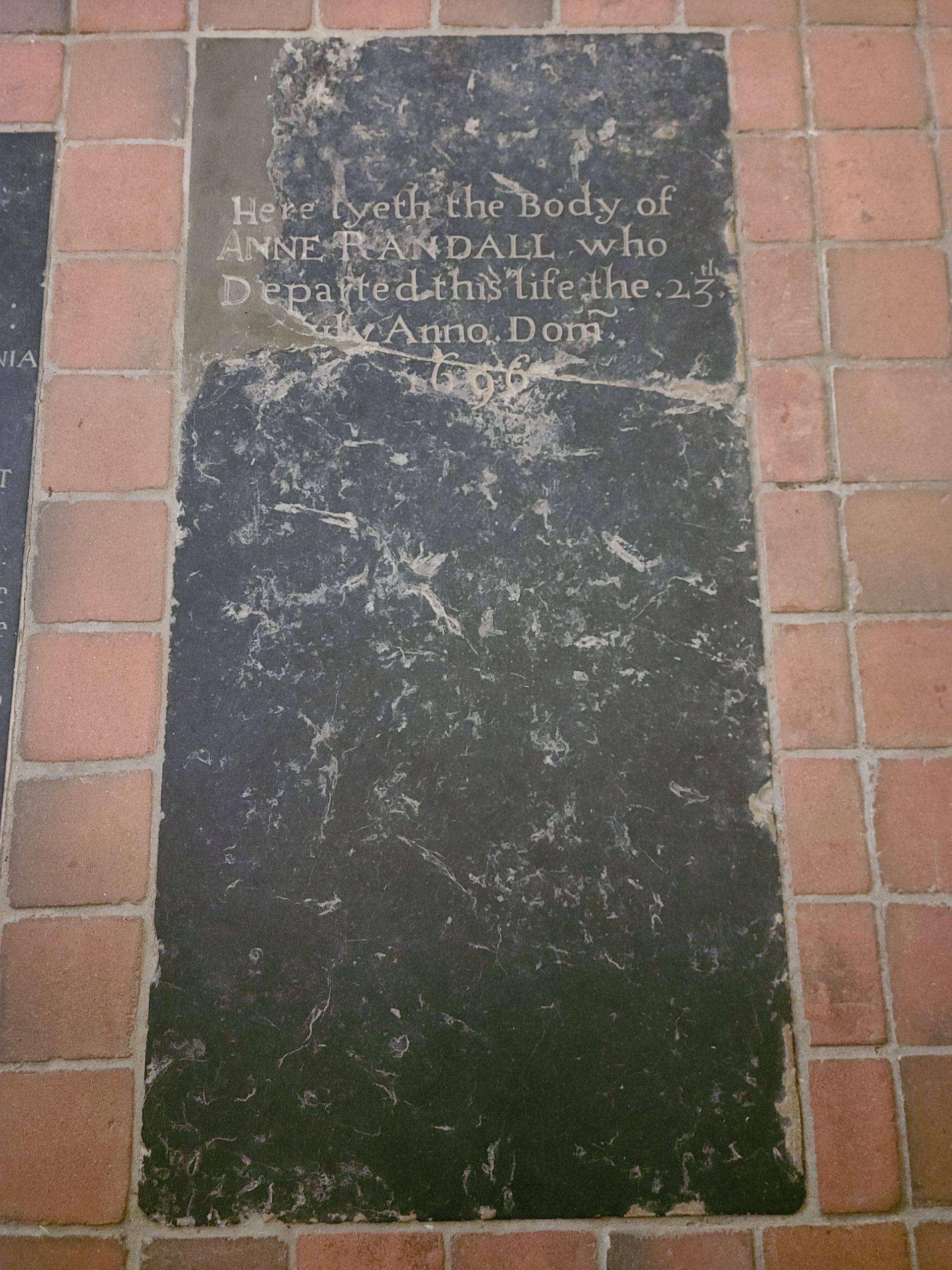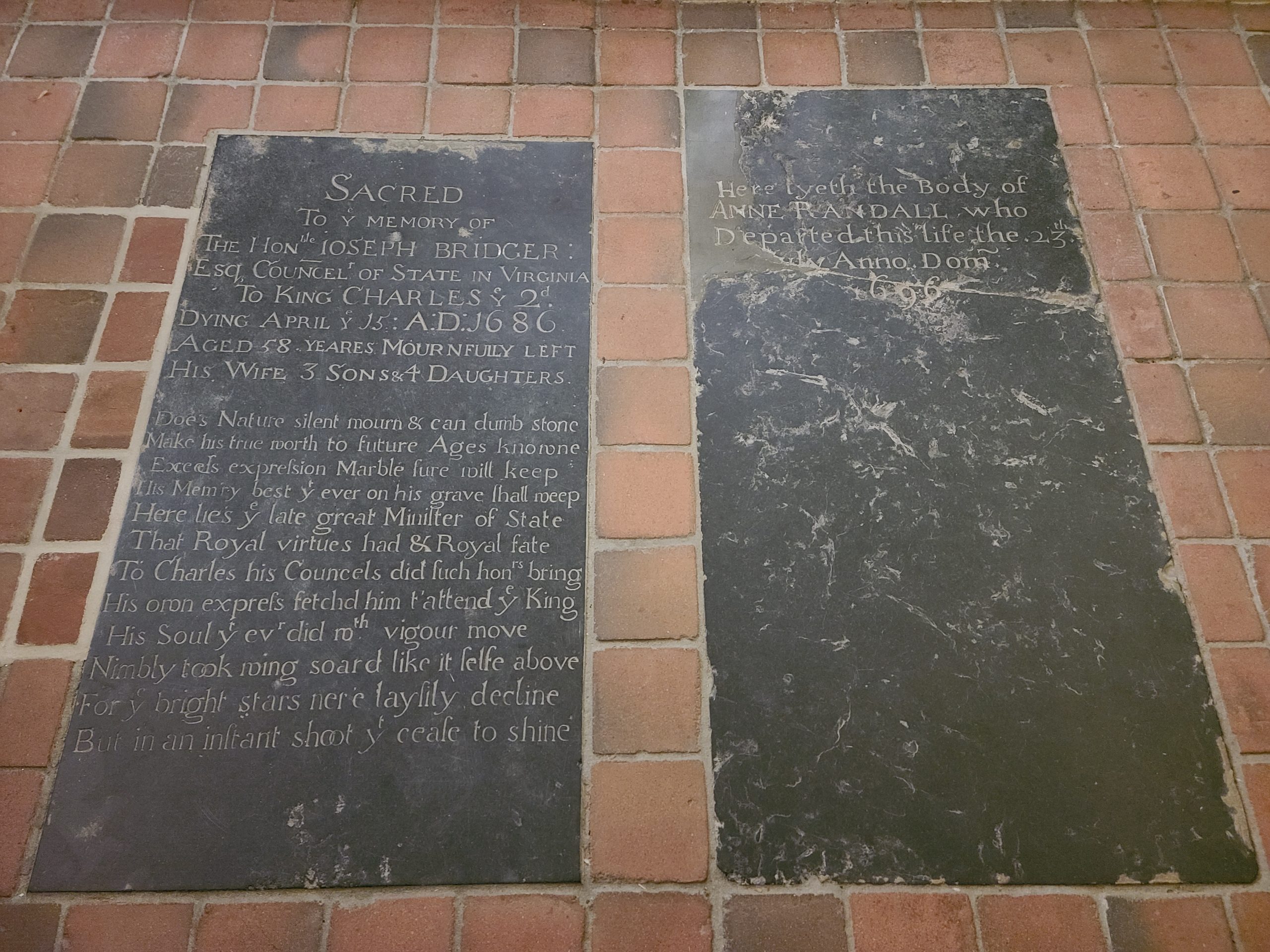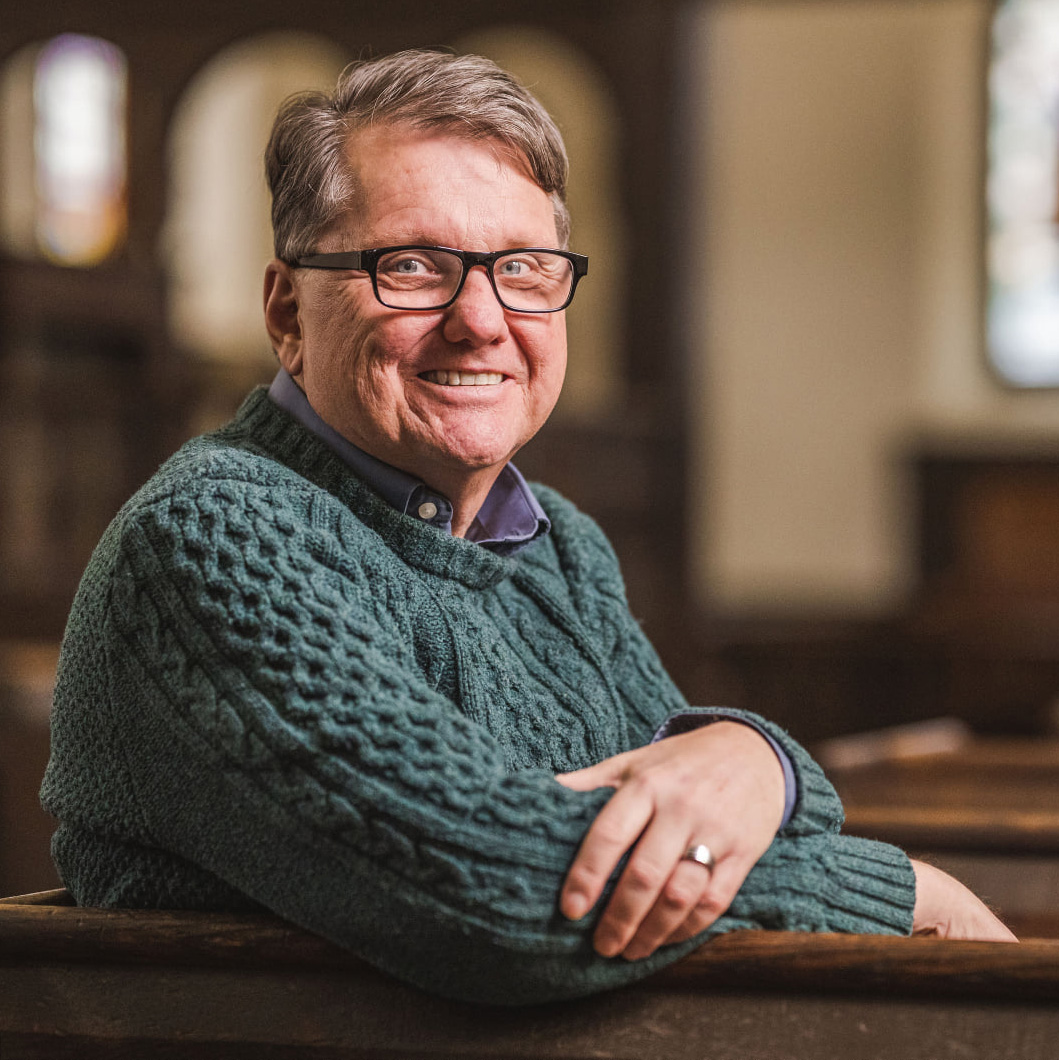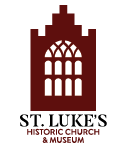St. Luke’s is about to embark on a final journey of sorts. In late January, researchers will come together to explore what remains in Anne Randall’s tomb. The “Old Brick Church” of St. Luke’s has been a resting place for its guarantor, Colonel Joseph Bridger, but who is this person resting next to him in the chancel floor and what is in her tomb? Soon we hope to answer these questions and share them with you.
Bridger Family Ties
Anne Randall was laid to rest in White Marsh, Virginia, south of the church on the Bridger Family Plantation. Questions began to arise about her relationship with Colonel Bridger. There was speculation about her having some connection to the Pitt family; Joseph Bridger married Hester Pitt in 1653 or 1654. Janet Ross, genealogical researcher and member of the Bridger Family Association, was able to find some answers pertaining to Anne’s familial relationship to the Bridgers. According to Ross, the first mention of Anne Randall is in the Isle of Wight records stemming from a will left by her first husband, Robert Watson. Watson was recorded to have passed on October 9th, 1652, leaving Anne a widow. Ross, in 2020, in a miraculous discovery, found that Anne’s second marriage was to Henry Pitt, the brother of Col. Robert Pitt and, therefore, the Uncle to Hester Pitt Bridger. Placing Anne Randall as a relative through marriage to Joseph Bridger by Hester Pitt.
The History of Anne Randall
Anne would marry again to a gentleman named Henry Pitt, the brother of Col. Robert Pitt and the uncle of Hester Pitt Bridger. The two were speculated to have been married in 1655, though with no official documentation to date their marriage in said year. Though the only documents that indicate their union stemmed from a land purchase of 200 acres from James and Mary Watson. James was the brother of Robert Watson, and the land was that of Robert Watson’s life and death.
In 1665, Henry Pitt would meet his end, and Anne would remarry to Col. James Powell. Powell, interestingly enough, was one of the appraisers of the Joseph Bridger Estate in 1686. Anne and Powell would maintain a marriage for nearly 27 years until his estimated death between 1692 and 1693. This would leave Anne a three-time widower.
Anne’s fourth and final husband would be Capt. Robert Randolph Randall. Their marriage would last until the death of Anne, leaving behind no children. After her death, she was buried at White Marsh Plantation along with Bridger family members, where she would rest until her exhumation from White Marsh and reinterment in the chancel of the Old Brick Church in 1894. In 1894, St. Luke’s was concluding the first renovation of the interior under a project undertaken by Christ Episcopal Church, Smithfield. Both Col. Bridger’s and Anne Randall’s ledger stones were moved along with their remains to the chancel of the Old Brick Church – or were they?
Part I: The Search for Joseph Bridger: The Exhumation of Bridger
In 2007, the first phase in searching for Joseph Bridger began with his exhumation. The project was supported by the Smithsonian as part of the larger project named “Written in Bone”. In 2007, Col. Joseph Bridger’s exhumation had some challenges, including navigating a water pipe to get to the remains of Col. Bridger that were in a brick box. However, it was not his entire skeleton. Less than twenty percent of Bridger’s remains were discovered, many of the bones having been broken up to make them fit into the brick box. Animal bones were also found mixed in with the human remains. Forensic analysis of Col. Bridger’s remains found high lead content, seven times beyond the normal levels. In Bridger’s will, an inventory found more than four hundred pounds of pewter which had a high concentration of lead. The lead poisoning was known during the period as the “dry gripes.” Bridger’s remains were later reinterred in the chancel of St. Luke’s in February of 2014. Since this project yielded an incomplete skeleton, St. Luke’s and the Bridger Family Association wanted to recover more of his remains and at the same time learn more about the life and times around his family.
Part II: The Search for Joseph Bridger: The White Marsh Dig
In 2018, the Alain Outlaw of Archaeological & Cultural Solutions, Inc., began a three-year-long archaeological dig to uncover the house that Col. Bridger had built on property given to him and his wife Hester in the 1670s. The team was also searching for the remainder of Bridger’s remains. The effort was very successful in terms of the discovery of the house and many exciting artifacts, but Bridger’s grave shaft had no remains left in it. Where did we go from there. One last place remains – Anne Randall’s tomb.
Part III: The Search for Joseph Bridger: The Anne Randall Project
The final phase of the “Searching for Joseph Bridger” project will be the exhumation of whatever lies beneath the ledger stone of Anne Randall. In January 2023, the mystery will begin to unfold. Through video footage, podcasting, and blogs, we will document the project and the ins and out of this historical pursuit of knowledge.
The team of Archaeological & Cultural Solutions, Inc., and the Smithsonian, under the direction of Dr. Doug Owsley, the head of Physical Anthropology at the Smithsonian’s National Museum of Natural History, will begin the analysis of the possible remains to be discovered. There is a possibility that more of Joseph Bridger’s remains will be found alongside those of Anne Randall.
Still, Mrs. Randall’s story deserves its time in the spotlight the same way that Mr. Bridger has had his. Women’s stories are often left untold in the annals of history. With the exhumation of Anne Randall’s grave, we hope to find out more about the woman and her lifestyle. How does her story hold up to the many other told and untold stories of the women in the greater Chesapeake area of 17th-century America? Why was she important enough to be placed beside the man who endowed the “Old Brick Church”?
Keep up to date with this project and future blog posts by signing up for our Email Blast!
St. Luke’s Historic Church & Museum is eager and excited about what we may learn in the coming year. We are grateful to the Bridger Family Association, TowneBank Foundation, and scores of other donors for generously underwriting the ongoing research on Joseph Bridger. We also wish to express deep appreciation to the Virginia Department of Historic Resources (VDHR), Isle of Wight County, Virginia and the Isle of Wight Museum, and the Isle of Wight Historical Society for endorsing this pursuit of cultural knowledge. We finally wish to thank our partners and contractors of Archaeological & Cultural Solutions, Inc., Hogg Funeral Home, and the Smithsonian Institutions. Stay tuned to our website, https://stlukesmuseum.org, and to our social media platforms. We will be excited to share all that we learn from this third and final phase of “The Search for Joseph Bridger”.

Above: A picture of the grave site of Anne Randall with an inscription, “Here lyeth the Body of ANNE RANDALL who Departed this life the 23th July Anno Dom. 1696

Above: A picture of the grave site of Col. Joseph Bridger (Left) and Anne Randall, relative through marriage (Right)

Above: A photo of Col. Joseph Bridger’s burial site. The inscription on the stone gives the date of his death as April 1686. The inscription compares him to a shooting star descending.
Enjoy this article? Please consider supporting St. Luke’s with a donation!

About the Author
John Ericson is the Education Coordinator and a Public Historian for St. Luke’s Historic Church & Museum. John holds a degree in History from Roanoke College and a Masters of Divinity from the Lutheran Theological Seminary at Gettysburg. In addition to John’s role at St. Luke’s, he is the Pastor of Reformation Lutheran Church in Newport News, Virginia. John is married to Oneita Jamerson Ericson, a native of Isle of Wight County, Virginia. They have three sons, Matthew, Thomas, and James, as well as two granddaughters, Carys and Lennon. The Ericsons currently reside in Hampton, Virginia. John has been teaching Reformation History and the Early American Religious Experience for more than thirty years.
